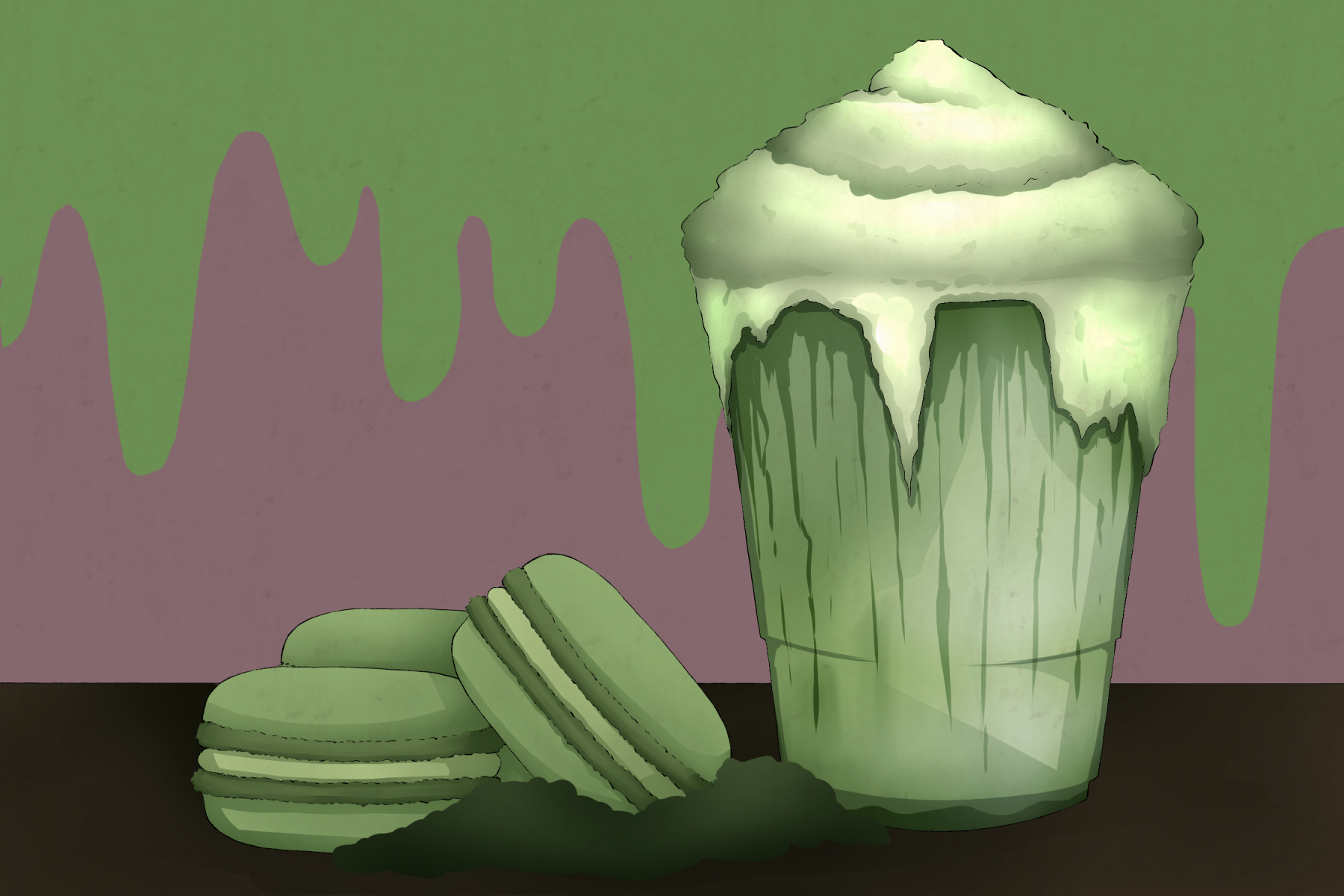The infamous pumpkin spice latte has been upstaged by social media’s newest trend: matcha. With its subtle sweetness and rich, slightly bitter flavor, matcha has swarmed cafes and restaurants alike. Social media creators and chefs have even used it to invent food fusions with the tea powder, such as matcha mochi waffles and Matcha Mylkbar’s matcha soy-chicken burger. With its bright green color, matcha is the perfect addition to reinventions of classic dishes.
Matcha has a long and rich history that predates its recent social media rise. Originating in China, the tea was treated as a luxury and status symbol. Then the green powder was brought to Japan, where drinking matcha tea became a common practice in Zen Buddhism. Not only could the tea sustain one’s energy and focus during meditation, but it was also believed to possess many health benefits. This is one of its appeals in the modern day, as matcha contains 10 times the amount of antioxidants as green tea and improves one’s cardiovascular health, cholesterol levels and immunity. Alongside boosting energy and concentration, matcha also does not lead users to experience the ‘caffeine crash’ that normally occurs when drinking coffee. Its health benefits make matcha an appealing drink for modern-day consumers.
Even so, the bright green drink has diverted from its roots as a cultural staple in tea ceremonies. Nowadays, social media has popularized the drink as a status of health and wealth. In 2015, actress Gwyneth Paltrow propelled matcha’s popularity in the West when she posted a picture of herself drinking a matcha latte on Instagram. She captioned it a “new dreamy discovery to warm up a wintry day,” portraying it as a ‘discovery’ to an American audience. The perception of matcha as a healthy superfood has also made the drink an essential for “that girl,” a current aesthetic and lifestyle trend that focuses on productivity, self-care and exercise. Matcha, a healthy and aesthetically pleasing drink, perfectly fits the lifestyle of ‘that girl.’ It is a product of nutritionism: “rather than highlighting the cultural markers of matcha that make it distinctly Japanese and framing it as other or exotic, [people] are instead hyperfocused on its nutritional qualities.” The drink’s expensive price is also a subtle indicator of one’s financial status. Kathleen Hou, a writer for The Cut, called matcha the “new green drink of privilege.” Los Angeles and New York, two of the U.S.’s most expensive places to live, were also the top two cities that searched for matcha on Google. In 2020, the global matcha market surpassed over 3 billion USD and is estimated to grow to above 5.5 billion in 2027. The green drink’s prevalence in the Western market has steadily grown, further cultivating its image as a status symbol.
This rise of matcha on social media has caused large corporations like Starbucks and Trader Joe’s to offer their own matcha drinks and powders. When searching the term ‘matcha’ on Google, the second and third top searches are ‘Starbucks matcha’ and ‘Starbucks.’ Although these brands enable matcha to be accessible worldwide, their products are also alarmingly inauthentic. Ceremonial grade matcha is the highest quality of matcha and is used during traditional Japanese tea ceremonies. It’s expensive and requires a meticulous preparation process. Thus, large franchises presumably use culinary grade matcha, which is cheaper, has a less vibrant green color and a more bitter taste. To combat the bitterness, corporations use more sugar: Starbucks’ grande-size matcha latte contains 28 grams of sugar, undermining the health benefits and associations of the tea. On one hand, the popularity of matcha causes brands to inevitably offer it. If they do not, they are missing out on the ever-growing market for consumers. However, some brands use the associations of matcha to market lower-grade quality tea under the claim that it possesses the same benefits. Ultimately, these corporations possess a large market audience that can influence its customers to try their brand of drink instead of authentic matcha from Asian brands.
Western brands have also invented matcha combinations with other flavors. Social media influencer Emma Chamberlain’s brand Chamberlain Coffee features products such as vanilla and mango-flavored matcha powders. The brand claims to be “made from Ceremonial Grade A, 100% Japanese green tea.” For Chamberlain Coffee’s mango-flavored matcha powder, the reviews were overwhelmingly positive, with one reviewer stating they were “pleasantly surprised” and that the “mango flavor is so natural and subtle and delicious.” Although brands like Chamberlain Coffee mention their investment in ceremonial grade matcha, the real root of the problem is that these brands fail to acknowledge that matcha is used in traditional Japanese practices. Chamberlain Coffee’s mango matcha flavor is called “a trip to the tropics,” a far cry from its roots in Asian culture. As Nick Dreher writes in his essay for the Graduate Journal of Food Studies, “In the United States, matcha is not clearly tied to Japan or the traditional ways it is consumed there. In a sense, matcha has become a food from nowhere.”
Matcha is not the only Asian food that has become popularized by social media. Taro from Southeast Asia and chai originating from India have turned into taro milk tea and chai sugar cookies (popularized by Taylor Swift). Asian foods are just the beginning of Asian culture being commercialized by non-Asian brands. Companies produce jade face rollers that subtly hint at Chinese culture but do not name their Chinese, African Egyptian nor Mayan roots in facial massage. Foreign and “exotic” cultures will always be commercialized, but it’s up to consumers to understand and recognize their cultural roots. The next time when you’re in line for Starbucks, will you be tantalized by the bright green drink featured on their menu, or will you recognize it as yet another product of commercialization?

















